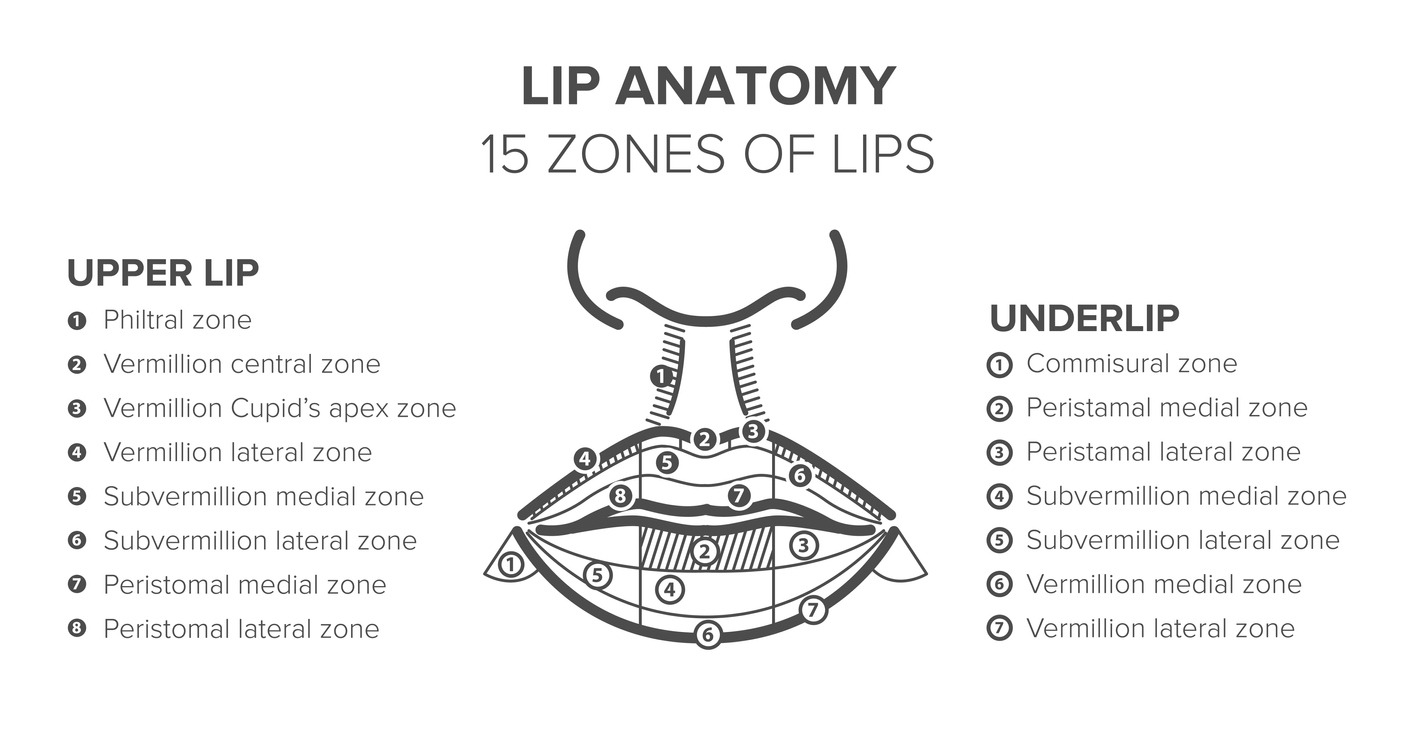The human lips, also known as “labia oris,” are the gateway to the oral cavity, a focal point of facial aesthetics, and a highly functional structure contributing to various aspects of our daily lives, from speech to sensation, and from expression to affection.
Lip Structure and Composition
The lips are a complex system made up of skin, muscle, and mucosa. They consist of an outer layer known as the epidermis, similar to the rest of the skin, but the lips are unique because they transition at the vermilion border to a thinner, more delicate type of skin that is the inner mucosal layer. This transition zone is highly vascular, which accounts for the lips’ characteristic red or pink hue.
Beneath the skin lies the orbicularis oris muscle, which encircles the mouth and controls lip movement and expression. This muscle is unique because it doesn’t attach to the bone but rather interlaces with the muscles of the cheeks and chin, allowing for a broad range of movements.
The 8 key components of the upper lip (also known as the procheilon) are:
- Philtral zone
- Vermillion central zone
- Vermillion Cupid’s apex zone
- Vermillion lateral zone
- Subvermillion medial zone
- Subermillion lateral zone
- Peristomal medial zone
- Peristomal lateral zone
The 7 key components of the under lip are:
- Commisural zone
- Peristamal medial zone
- Peristamal lateral zone
- Subvermillion medial zone
- Subvermillion lateral zone
- Vermillion medial zone
- Vermillion lateral zone
Blood Supply and Innervation
The blood supply to the lips is rich, stemming from branches of the facial artery — the superior and inferior labial arteries. This extensive blood supply not only nourishes the lips but also contributes to their sensitivity and their ability to heal quickly from minor injuries.
Nerves provide the lips with a high degree of sensation. The infraorbital nerve, a branch of the trigeminal nerve, supplies the upper lip, while the mental nerve supplies the lower lip. This innervation pattern makes the lips one of the most sensitive parts of the human body, capable of detecting even the slightest changes in texture, temperature, and pressure.
Purpose and Functionality
Functionally, the lips are essential for various modes of communication. They help form the sounds of speech, serving as a flexible gate that can open and close, change shape, and vibrate to influence the production of different phonemes.
In addition to their role in verbal communication, the lips are also pivotal in non-verbal expressions. They can convey emotions such as happiness, sadness, surprise, and anger through various movements and positions, making them a critical aspect of our facial expressions.
Sensory Role
Lips have numerous nerve endings that make them sensitive to touch, temperature, and pain. This sensitivity serves as a protective mechanism, helping us to detect and react to stimuli that may pose a threat to our well-being, such as extreme heat or cold.
Aesthetic and Cultural Aspects
Aesthetically, the lips are considered one of the defining features of the face, with different cultures and historical periods having varying standards of what constitutes beautiful or desirable lips. Lip makeup, such as lipstick or lip gloss, is often used to enhance the lips’ appearance, making them more noticeable or changing their natural color.
Speech Production
One of the primary functions of the lips is in the articulation of speech. The lips work in conjunction with the teeth, tongue, and palate to help form phonetic sounds that are essential to language. Certain sounds, known as bilabial consonants, such as the letters “p,” “b,” and “m,” are produced by bringing both lips together. Meanwhile, labiodental sounds like “f” and “v” are created by touching the bottom lip to the upper teeth. The ability to control the movement, shape, and tension of the lips is critical for clear speech and effective verbal communication.
Expression of Emotions
The lips are highly expressive and can convey a wide range of emotions without a single word being spoken. A smile can signify happiness or approval, a frown can express disapproval or sadness, and pursed lips can indicate thoughtfulness or skepticism. This non-verbal communication is a universal language, understood across cultures and societies.
Intake of Food and Liquids
The lips form the initial barrier and guide for food and liquid intake, playing a vital role in the mechanics of eating and drinking. They help to seal the mouth and prevent food from falling out, and they can also be used to suck liquids, which is an essential function for infants who breastfeed.
Breastfeeding
Speaking of infants, the lips are crucial for creating a seal around the mother’s nipple during breastfeeding. This action is instinctual and is aided by the natural evert (turning outward) of the infant’s lips to form a tight suction, enabling them to draw out milk.
Protection
Lips also serve a protective function. They close the mouth and keep out unwanted particles and potentially harmful substances. When we encounter something dangerous or inedible, it is often the lips that are the first to react, closing off to prevent ingestion.
Facial Aesthetics
From an aesthetic perspective, the lips contribute to the symmetry and appeal of the face. Full and well-defined lips are often associated with youth and beauty, and they play a significant role in facial attractiveness. This is why cosmetic procedures such as lip fillers have become popular to enhance the lips’ appearance.
Enabling Suction
The lips allow for the creation of negative pressure within the mouth, which is not only essential for effective breastfeeding in infants but also enables actions such as drinking through a straw or smoking.
Aid in Chewing
Lips help to keep the food between our teeth while we chew, playing a subtle yet important role in the process of mastication. They work with the cheeks to keep the food from escaping the mouth and assist in the formation of a bolus (chewed food) before swallowing.
Articulation of Affection
Lips are often considered the gateway to intimacy and are fundamental in the articulation of affection and love, especially through acts like kissing. This act has deep biological roots associated with bonding and the assessment of a potential mate’s compatibility through close physical contact.
Heat Dissipation
The lips also help in regulating the body’s temperature. When over-heated, humans might pant or breathe heavily through their mouths, allowing the moisture on the lips and the saliva to evaporate, which can help cool down the body slightly.
Taste
While the lips themselves do not contain taste buds, they are integral to the act of tasting by keeping the food and drink in the mouth and contributing to the manipulation of food to come into contact with the taste receptors on the tongue.
Indicator of Health
The color, texture, and condition of the lips can also be indicators of a person’s overall health. Pale lips might suggest anemia, blue lips can indicate poor oxygenation, and dry or cracked lips can signal dehydration or other health conditions.
Conclusion
The anatomy of the lips is a testament to their multifaceted role in human biology and daily life. From their complex structure and rich sensory innervation to their expressive capabilities and impact on aesthetics, the lips are a small yet remarkably significant feature of the human body.
The function of the lips is deeply intertwined with human behavior, health, and communication. They are not only central to several physical processes but are also emblematic of human emotion and expression, serving as a powerful tool for non-verbal communication. Whether it’s forming words, savoring a meal, expressing feelings, or playing an instrument, the lips are fundamental to many aspects of life. Understanding the intricate anatomy of the lips can inspire a deeper appreciation for the various roles they play, from the biological to the psychological, underscoring their importance in health, communication, and social interaction.





